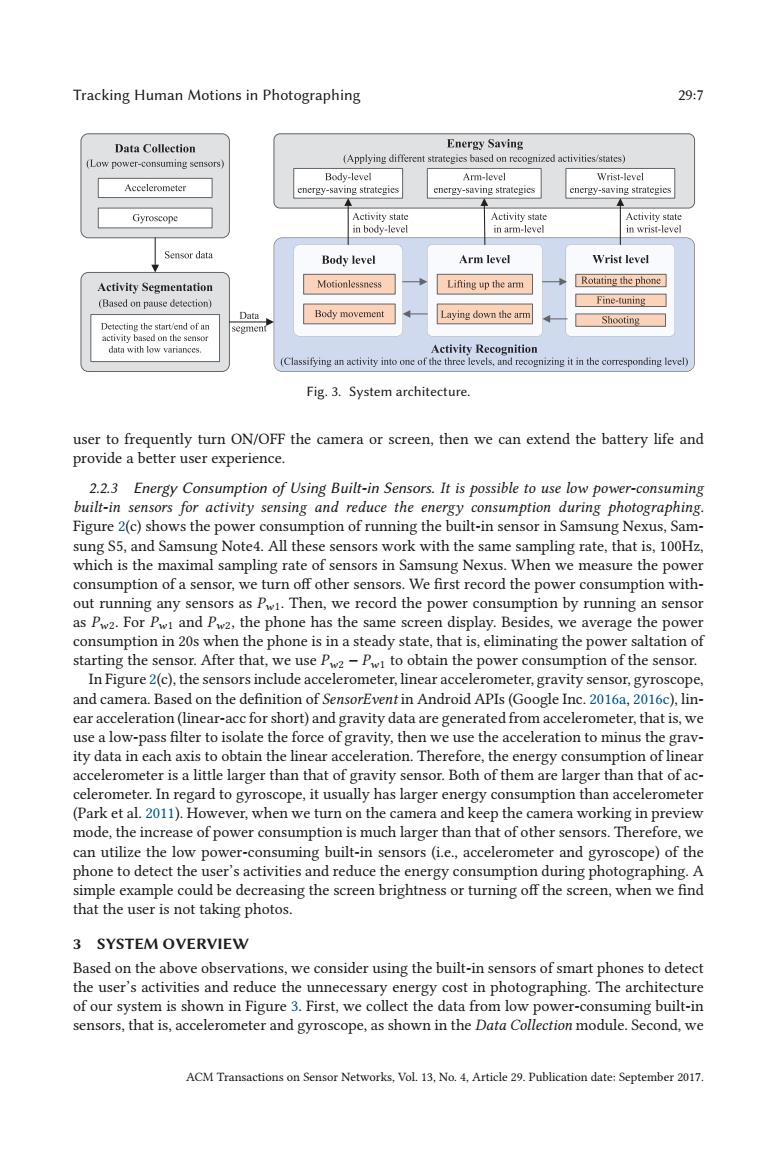正在加载图片...

Tracking Human Motions in Photographing 29:7 Data Collection Energy Saving (Low power-consuming sensors) (Applying different strategies based on recognized activities/states) Body-level Arm-level Wrist-level Accelerometer energy-saving strategies energy-saving strategies cnergy-saving strategies 热 Gyroscope Activity state Activity state Activity state in body-level in arm-level in wrist-level Sensor data Body level Arm level Wrist level Activity Segmentation Motionlessness Lifting up the arm Rotating the phone】 (Based on pause detection) Fine-tuning Data Body movement Laying down the arm Detecting the start/end of an Shooting activity based on the sensor data with low variances. Activity Recognition (Classifying an activity into one of the three levels,and recognizing it in the corresponding level) Fig.3.System architecture. user to frequently turn ON/OFF the camera or screen,then we can extend the battery life and provide a better user experience. 2.2.3 Energy Consumption of Using Built-in Sensors.It is possible to use low power-consuming built-in sensors for activity sensing and reduce the energy consumption during photographing. Figure 2(c)shows the power consumption of running the built-in sensor in Samsung Nexus,Sam- sung S5,and Samsung Note4.All these sensors work with the same sampling rate,that is,100Hz, which is the maximal sampling rate of sensors in Samsung Nexus.When we measure the power consumption of a sensor,we turn off other sensors.We first record the power consumption with- out running any sensors as Pw1.Then,we record the power consumption by running an sensor as Pw2.For Pwi and Pw2,the phone has the same screen display.Besides,we average the power consumption in 20s when the phone is in a steady state,that is,eliminating the power saltation of starting the sensor.After that,we use Pw2-PwI to obtain the power consumption of the sensor. In Figure 2(c),the sensors include accelerometer,linear accelerometer,gravity sensor,gyroscope, and camera.Based on the definition of SensorEvent in Android APIs(Google Inc.2016a,2016c),lin- ear acceleration(linear-acc for short)and gravity data are generated from accelerometer,that is,we use a low-pass filter to isolate the force of gravity,then we use the acceleration to minus the grav- ity data in each axis to obtain the linear acceleration.Therefore,the energy consumption of linear accelerometer is a little larger than that of gravity sensor.Both of them are larger than that of ac- celerometer.In regard to gyroscope,it usually has larger energy consumption than accelerometer (Park et al.2011).However,when we turn on the camera and keep the camera working in preview mode,the increase of power consumption is much larger than that of other sensors.Therefore,we can utilize the low power-consuming built-in sensors (i.e.,accelerometer and gyroscope)of the phone to detect the user's activities and reduce the energy consumption during photographing.A simple example could be decreasing the screen brightness or turning off the screen,when we find that the user is not taking photos. 3 SYSTEM OVERVIEW Based on the above observations,we consider using the built-in sensors of smart phones to detect the user's activities and reduce the unnecessary energy cost in photographing.The architecture of our system is shown in Figure 3.First,we collect the data from low power-consuming built-in sensors,that is,accelerometer and gyroscope,as shown in the Data Collection module.Second,we ACM Transactions on Sensor Networks,Vol.13,No.4,Article 29.Publication date:September 2017Tracking Human Motions in Photographing 29:7 Fig. 3. System architecture. user to frequently turn ON/OFF the camera or screen, then we can extend the battery life and provide a better user experience. 2.2.3 Energy Consumption of Using Built-in Sensors. It is possible to use low power-consuming built-in sensors for activity sensing and reduce the energy consumption during photographing. Figure 2(c) shows the power consumption of running the built-in sensor in Samsung Nexus, Samsung S5, and Samsung Note4. All these sensors work with the same sampling rate, that is, 100Hz, which is the maximal sampling rate of sensors in Samsung Nexus. When we measure the power consumption of a sensor, we turn off other sensors. We first record the power consumption without running any sensors as Pw1. Then, we record the power consumption by running an sensor as Pw2. For Pw1 and Pw2, the phone has the same screen display. Besides, we average the power consumption in 20s when the phone is in a steady state, that is, eliminating the power saltation of starting the sensor. After that, we use Pw2 − Pw1 to obtain the power consumption of the sensor. In Figure 2(c), the sensors include accelerometer, linear accelerometer, gravity sensor, gyroscope, and camera. Based on the definition of SensorEvent in Android APIs (Google Inc. 2016a, 2016c), linear acceleration (linear-acc for short) and gravity data are generated from accelerometer, that is, we use a low-pass filter to isolate the force of gravity, then we use the acceleration to minus the gravity data in each axis to obtain the linear acceleration. Therefore, the energy consumption of linear accelerometer is a little larger than that of gravity sensor. Both of them are larger than that of accelerometer. In regard to gyroscope, it usually has larger energy consumption than accelerometer (Park et al. 2011). However, when we turn on the camera and keep the camera working in preview mode, the increase of power consumption is much larger than that of other sensors. Therefore, we can utilize the low power-consuming built-in sensors (i.e., accelerometer and gyroscope) of the phone to detect the user’s activities and reduce the energy consumption during photographing. A simple example could be decreasing the screen brightness or turning off the screen, when we find that the user is not taking photos. 3 SYSTEM OVERVIEW Based on the above observations, we consider using the built-in sensors of smart phones to detect the user’s activities and reduce the unnecessary energy cost in photographing. The architecture of our system is shown in Figure 3. First, we collect the data from low power-consuming built-in sensors, that is, accelerometer and gyroscope, as shown in the Data Collection module. Second, we ACM Transactions on Sensor Networks, Vol. 13, No. 4, Article 29. Publication date: September 2017